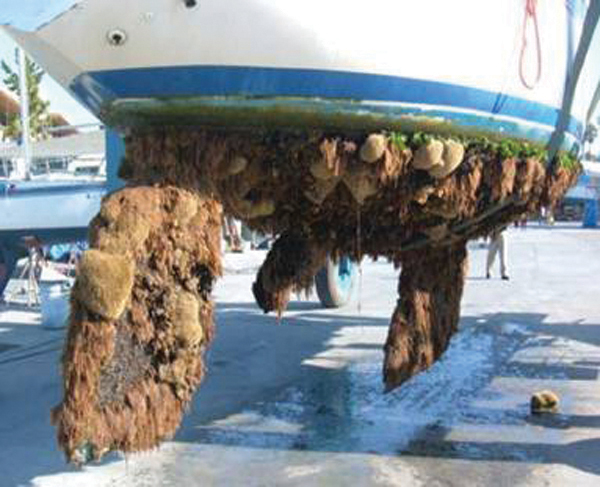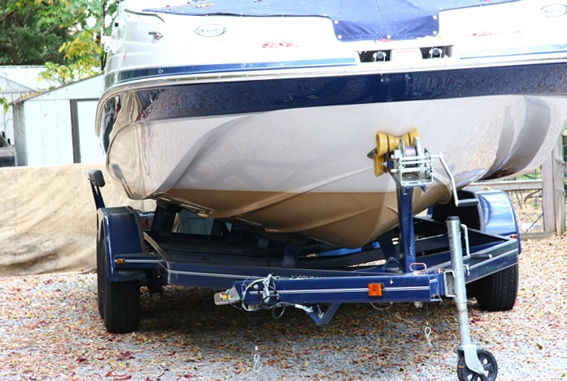If you leave your boat in the water for any appreciable amount of time, Mother Nature is going to take up residence on the bottom of your boat’s hull, the gearcase, and other underwater running gear in a matter of just a week or two.
Slime, algae, mussels, barnacles, and other aquatic species cling to a clean hull like a magnet. In the world of boating, we call a hull with stuff growing on it “fouled.” We’re all for letting sea creatures do what comes naturally, but when these critters mess with our boats, all kinds of bad things can happen.
For starters, a fouled hull isn’t slick and smooth, and doesn’t move through the water easily, thus requiring more fuel to maintain speed. In cases of extreme fouling, so many creatures and organisms on the bottom can affect the boat’s handling.
Additionally, if you let the slime and crud stay on the boat long enough, hull damage could occur from the excretions of your submerged stowaways.
Therefore, it may be in your best interest to fight back by applying antifouling paint to hull from the waterline down.
Most antifouling coatings contain copper-based chemical blends that boat-attacking aquatic organisms find distasteful. One slurp of a coated boat hull will send ‘em packing to find another, more hospitable place to live. It’s a lot like squirting on bug spray to keep the mosquitoes away on a summer’s night.

Ablative Antifouling Paints
Ablative antifouling paints slowly erode as the boat travels through the water, washing away aquatic build-up, exposing a fresh layer of paint to maintain a constant level of protection. Most ablative coatings do a good job of controlling zebra mussels and barnacles, and many formulations prevent algae, slime, and weed growth.
Standard Ablative Antifouling Paint
For standard ablative paint to work, you need to use your boat frequently. If the boat is tied up to the dock for extended periods, the bottom will become fouled because there isn’t any water flowing under the hull to remove the outermost layer of antifouling paint and all the slime, algae, barnacles.
Most ablative antifouling paints contain copper antifouling agents, and can be out of the water for upwards of a couple of months without adversely affecting the antifouling capabilities. You can trailer the boat if necessary; however, the bunks or rollers will remove layers of paint in the process.
Ablative antifouling paints are usually reapplied annually, so add “paint boat bottom” to your recommissioning checklist.
Copolymer Self-Polishing/Ablative Antifouling Paints
Advanced resin formulations make copolymer antifouling paints harder than standard antifouling coatings, and if you use the boat a lot, you can usually run the boat for multiple seasons before repainting the bottom.
Copolymer antifoulings release their protective repellants in precisely controlled doses – just enough prevent fouling on your boat, to minimize a potentially negative impact of the environment.
Although technically an ablative paint, the industry prefers to call copolymer antifouling coatings “self-polishing”, due to the extended time it takes for the paint to lose its effectiveness. As with the standard ablative paints, you can trailer a boat coated with copolymer antifouling if you must, and leave the boat out of the water for several weeks; as soon as it hits the water, the copolymer armor will be ready for action.
Copper-Free Ablative Antifouling Paints
In some places, decades of copper deposited from countless vessels’ antifouling paint has raised the concentrations of copper in the water to unacceptable levels. Therefore, in certain ports and waterways, copper-based antifouling paints are illegal, thus the need for antifouling paints that use alternative chemicals, rather than copper, to keep boat and ship hulls free from fouling.
As with standard ablative antifouling paints, plan on repainting the bottom annually.
Hard Antifouling Paints
As the name implies, these types of antifouling paints are hard, that is, the coating doesn’t gradually wear off with use, as do ablative coatings. Hard antifouling paints continually leach out chemicals, making them durable and functional bottom paints for stationary or slow moving vessels.
Boat racers love the slick, drag-reducing properties of hard antifouling paints, and the paint’s surface buffs out to an amazing sheen that can help the captain find a little more speed while the bottom remains fouling-free.

Can I Do This Myself?
You bet. According to our sources, over half the antifouling paints sold are for do-it-yourselfers.
The actual painting process isn’t nearly as difficult as preparing the hull to accept the antifouling paint. Antifouling paint isn’t cheap, so you have to make a commitment to prep the hull, step-by-step—without succumbing to cutting corners.
Think about where you’ll do the work, how to protect the boat from the elements, and if you’re truly willing to put in the hours to do the job properly.
If you’re really into hands-on boat maintenance, bottom painting is right up your alley. However; those who don’t derive satisfaction from such activities should have no problem hiring a professional.

Thankfully
On the majority of boats, the outboard wells are big enough to trim your Yamaha outboards completely out of the water, away from fouling organisms. Antifouling paint is readily available for Yamaha midsections, gearcases, and propellers if the setup won’t allow raising the outboards sufficiently to avoid marine growth.
Materials contained are intended to be used for general educational and informational purposes only. You are encouraged to seek the services of a qualified professional before utilizing or relying upon any information presented herein. While every effort has been made to ensure such accuracy of the information contained herein, Yamaha Motor Corporation, U.S.A .does not guarantee such accuracy, correctness, reliability or completeness of the information or anything related directly or indirectly to the use of this information in any way, and can’t be held liable for any errors in or any reliance upon this information.
Back to Blue Life
Slime, algae, mussels, barnacles, and other aquatic species cling to a clean hull like a magnet. In the world of boating, we call a hull with stuff growing on it “fouled.” We’re all for letting sea creatures do what comes naturally, but when these critters mess with our boats, all kinds of bad things can happen.
For starters, a fouled hull isn’t slick and smooth, and doesn’t move through the water easily, thus requiring more fuel to maintain speed. In cases of extreme fouling, so many creatures and organisms on the bottom can affect the boat’s handling.
Additionally, if you let the slime and crud stay on the boat long enough, hull damage could occur from the excretions of your submerged stowaways.
Therefore, it may be in your best interest to fight back by applying antifouling paint to hull from the waterline down.
Most antifouling coatings contain copper-based chemical blends that boat-attacking aquatic organisms find distasteful. One slurp of a coated boat hull will send ‘em packing to find another, more hospitable place to live. It’s a lot like squirting on bug spray to keep the mosquitoes away on a summer’s night.

Ablative Antifouling Paints
Ablative antifouling paints slowly erode as the boat travels through the water, washing away aquatic build-up, exposing a fresh layer of paint to maintain a constant level of protection. Most ablative coatings do a good job of controlling zebra mussels and barnacles, and many formulations prevent algae, slime, and weed growth.
Standard Ablative Antifouling Paint
For standard ablative paint to work, you need to use your boat frequently. If the boat is tied up to the dock for extended periods, the bottom will become fouled because there isn’t any water flowing under the hull to remove the outermost layer of antifouling paint and all the slime, algae, barnacles.
Most ablative antifouling paints contain copper antifouling agents, and can be out of the water for upwards of a couple of months without adversely affecting the antifouling capabilities. You can trailer the boat if necessary; however, the bunks or rollers will remove layers of paint in the process.
Ablative antifouling paints are usually reapplied annually, so add “paint boat bottom” to your recommissioning checklist.
Copolymer Self-Polishing/Ablative Antifouling Paints
Advanced resin formulations make copolymer antifouling paints harder than standard antifouling coatings, and if you use the boat a lot, you can usually run the boat for multiple seasons before repainting the bottom.
Copolymer antifoulings release their protective repellants in precisely controlled doses – just enough prevent fouling on your boat, to minimize a potentially negative impact of the environment.
Although technically an ablative paint, the industry prefers to call copolymer antifouling coatings “self-polishing”, due to the extended time it takes for the paint to lose its effectiveness. As with the standard ablative paints, you can trailer a boat coated with copolymer antifouling if you must, and leave the boat out of the water for several weeks; as soon as it hits the water, the copolymer armor will be ready for action.
Copper-Free Ablative Antifouling Paints
In some places, decades of copper deposited from countless vessels’ antifouling paint has raised the concentrations of copper in the water to unacceptable levels. Therefore, in certain ports and waterways, copper-based antifouling paints are illegal, thus the need for antifouling paints that use alternative chemicals, rather than copper, to keep boat and ship hulls free from fouling.
As with standard ablative antifouling paints, plan on repainting the bottom annually.
Hard Antifouling Paints
As the name implies, these types of antifouling paints are hard, that is, the coating doesn’t gradually wear off with use, as do ablative coatings. Hard antifouling paints continually leach out chemicals, making them durable and functional bottom paints for stationary or slow moving vessels.
Boat racers love the slick, drag-reducing properties of hard antifouling paints, and the paint’s surface buffs out to an amazing sheen that can help the captain find a little more speed while the bottom remains fouling-free.

Can I Do This Myself?
You bet. According to our sources, over half the antifouling paints sold are for do-it-yourselfers.
The actual painting process isn’t nearly as difficult as preparing the hull to accept the antifouling paint. Antifouling paint isn’t cheap, so you have to make a commitment to prep the hull, step-by-step—without succumbing to cutting corners.
Think about where you’ll do the work, how to protect the boat from the elements, and if you’re truly willing to put in the hours to do the job properly.
If you’re really into hands-on boat maintenance, bottom painting is right up your alley. However; those who don’t derive satisfaction from such activities should have no problem hiring a professional.

Thankfully
On the majority of boats, the outboard wells are big enough to trim your Yamaha outboards completely out of the water, away from fouling organisms. Antifouling paint is readily available for Yamaha midsections, gearcases, and propellers if the setup won’t allow raising the outboards sufficiently to avoid marine growth.
Materials contained are intended to be used for general educational and informational purposes only. You are encouraged to seek the services of a qualified professional before utilizing or relying upon any information presented herein. While every effort has been made to ensure such accuracy of the information contained herein, Yamaha Motor Corporation, U.S.A .does not guarantee such accuracy, correctness, reliability or completeness of the information or anything related directly or indirectly to the use of this information in any way, and can’t be held liable for any errors in or any reliance upon this information.
Back to Blue Life
